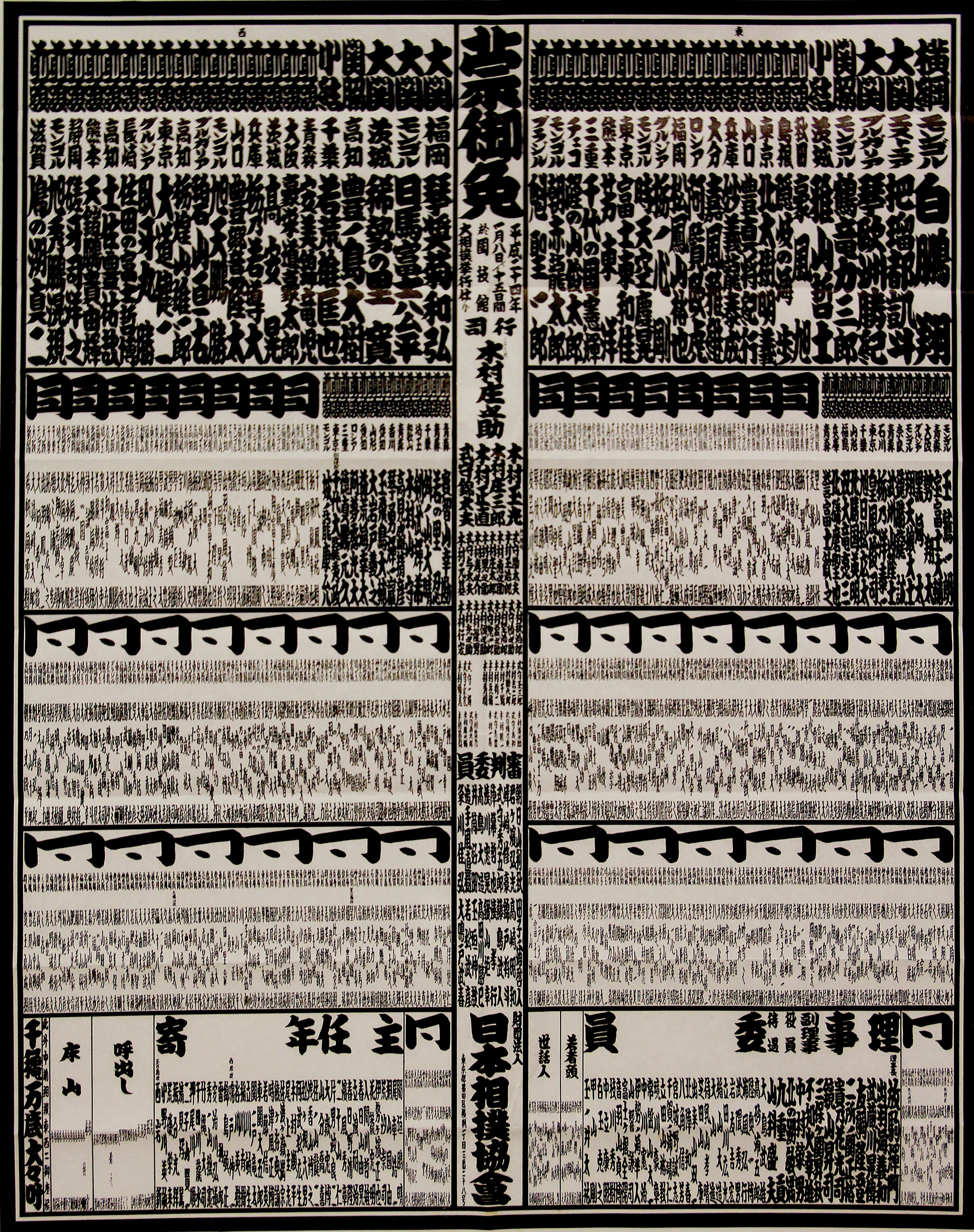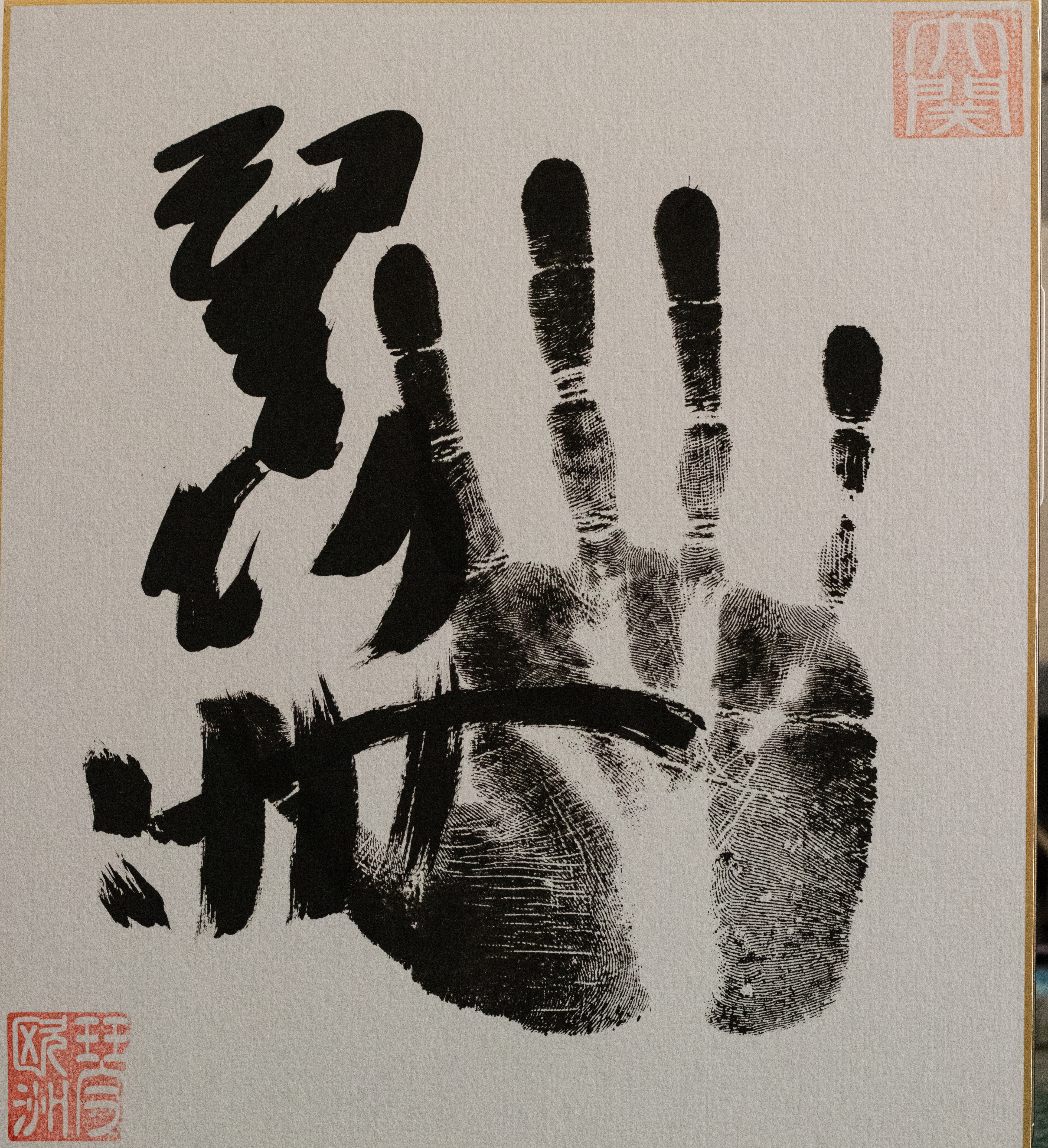|
Hōmashō Noriyuki
Hōmashō Noriyuki (born April 16, 1981 as Yōsuke Yamamoto in Shimonoseki, Yamaguchi Prefecture, Japan), is a former sumo wrestler. He turned professional in March 2004 and reached the top ''makuuchi'' division in May 2006 as the first ''sekitori'' from Shikoroyama stable, without any losing scores on his record. His highest rank was ''komusubi''. He earned seven special prizes in his top division career and was a runner-up in three tournaments. In March 2014 he took the championship in the ''jūryō'' division. Hōmashō was a popular wrestler among sumo fans, and was noted for his deep and graceful bow at the end of a match. Upon his retirement in January 2015 he became an elder of the Japan Sumo Association under the name of Tatsutagawa. Early life and sumo background He graduated from Saitama Sakae High School and was accepted by the Nihon University sumo club. However, due to cellulitis, he had to quit the club and instead did various part-time jobs in between attending lect ... [...More Info...] [...Related Items...] OR: [Wikipedia] [Google] [Baidu] |
Shikoroyama Stable
is a stable of sumo wrestlers, formerly part of the Tokitsukaze ''ichimon'' or group of stables. It was established in its current form in February 2004 by former ''sekiwake'' Terao Tsunefumi, who branched off from the Izutsu stable. He did not take any established wrestlers with him, recruiting all the wrestlers himself instead. In December 2017 Shikoroyama-''oyakata'' left the Tokitsukaze group along with Tatsutagawa-''oyakata'' (former ''komusubi'' Hōmashō) and Minato-''oyakata'' (former ''maegashira'' Minatofuji), announcing that he would not join any other ''ichimon'' but would support Takanohana in the January 2018 elections to the board of the Japan Sumo Association. In September 2018 the stable joined the Nishonoseki group. As of January 2023, the stable had 16 wrestlers. Hamatensei (real name Issei Amakusa), a junior wrestler who competed for the stable from 2011 to 2019, became a civil servant after completing a correspondence course as part of an arrangement betwee ... [...More Info...] [...Related Items...] OR: [Wikipedia] [Google] [Baidu] |
Sumo May09 Homasho
is a form of competitive full-contact wrestling where a ''rikishi'' (wrestler) attempts to force his opponent out of a circular ring (''dohyō'') or into touching the ground with any body part other than the soles of his feet (usually by throwing, shoving or pushing him down). Sumo originated in Japan, the only country where it is practiced professionally and where it is considered the national sport. It is considered a ''gendai budō'', which refers to modern Japanese martial arts, but the sport has a history spanning many centuries. Many ancient traditions have been preserved in sumo, and even today the sport includes many ritual elements, such as the use of salt purification, from Shinto. Life as a wrestler is highly regimented, with rules regulated by the Japan Sumo Association. Most sumo wrestlers are required to live in communal sumo training stables, known in Japanese as ''heya'', where all aspects of their daily lives—from meals to their manner of dress—are dict ... [...More Info...] [...Related Items...] OR: [Wikipedia] [Google] [Baidu] |
High Cholesterol
Hypercholesterolemia, also called high cholesterol, is the presence of high levels of cholesterol in the blood. It is a form of hyperlipidemia (high levels of lipids in the blood), hyperlipoproteinemia (high levels of lipoproteins in the blood), and dyslipidemia (any abnormalities of lipid and lipoprotein levels in the blood). Elevated levels of non-HDL cholesterol and LDL in the blood may be a consequence of diet, obesity, inherited (genetic) diseases (such as LDL receptor mutations in familial hypercholesterolemia), or the presence of other diseases such as type 2 diabetes and an underactive thyroid. Cholesterol is one of three major classes of lipids produced and used by all animal cells to form membranes. Plant cells manufacture phytosterols (similar to cholesterol), but in rather small quantities. Cholesterol is the precursor of the steroid hormones and bile acids. Since cholesterol is insoluble in water, it is transported in the blood plasma within protein particles (li ... [...More Info...] [...Related Items...] OR: [Wikipedia] [Google] [Baidu] |
Banzuke
A , officially called is a document listing the rankings of professional sumo wrestlers published before each official tournament (''honbasho''). The term can also refer to the rankings themselves. The document is normally released about two weeks before the tournament begins. On the ''banzuke'', wrestlers are divided into East, which is printed on the right, and West, which is printed on the left. Each wrestler's full ''shikona'' (ring name), hometown and rank is also listed. The top of the page starts with the highest ranked ''makuuchi'' wrestlers printed in the largest characters, down to the wrestlers in the lowest divisions which are written in much smaller characters. The names of ''gyōji'' (sumo referees), ''yobidashi'' (ushers/handymen), '' shimpan'' (judges), ''oyakata'' (elders of the Japan Sumo Association), and occasionally ''tokoyama'' (hairdressers) are also listed. While not as old as sumo itself, the form and production of this document can be traced as fa ... [...More Info...] [...Related Items...] OR: [Wikipedia] [Google] [Baidu] |
San'yaku
The following words are terms used in sumo wrestling in Japan. A B C D E F G H I J K M N O R S T W Y Z References External links Glossary of Sumo TermsSumopedia at NHK World-Japan {{Glossaries of sports Glossaries of sports, Sumo Sumo-related lists Sumo terminology, ... [...More Info...] [...Related Items...] OR: [Wikipedia] [Google] [Baidu] |
Toyonoshima
Toyonoshima Daiki (born June 26, 1983 as Daiki Kajiwara) is a former professional sumo wrestler from Sukumo, Kōchi, Japan. He made his professional debut in January 2002, reaching the top ''makuuchi'' division in September 2004. He was a runner-up in five tournaments, and earned ten sansho (sumo), special prizes. His highest rank was ''sekiwake'', which he first reached in September 2008 and held for five tournaments in total. Following a suspension in July 2010 he was demoted to the ''jūryō'' division, but upon his return to ''makuuchi'' in November 2010 he took part in a playoff for the championship. He won four ''kinboshi'' or gold stars awarded for ''yokozuna'' upsets, three of them earned by defeating Harumafuji from 2013 to 2015. He wrestled for Tokitsukaze stable. He retired in 2020 and is now an toshiyori, elder of the Japan Sumo Association under the name of Izutsu-''oyakata''. Early life and sumo background Toyonoshima is the oldest son of a tofu maker. In his early ... [...More Info...] [...Related Items...] OR: [Wikipedia] [Google] [Baidu] |
Sanshō (sumo)
are the three special prizes awarded to top (''Makuuchi'') division sumo wrestlers for exceptional performance during a sumo ''honbasho'' or tournament. The prizes were first awarded in November 1947. Criteria All wrestlers in the top division below the rank of '' ōzeki'' are eligible. In order to be considered for a special prize a rikishi must make a ''kachi-koshi'' or majority of wins during the tournament. Among eligible rikishi, the prize winners are decided by a panel which includes press writers covering the tournament. There is no requirement that the prizes must be awarded, and it sometimes happens that one or more of the ''sanshō'' are not given. It is also common for an award to be awarded to more than one wrestler. The three prizes are *, Outstanding Performance prize *, Fighting Spirit prize *, Technique prize Typically the ''Ginō-shō'' is awarded to a wrestler or wrestlers who display the most skillful ''kimarite'', or techniques; the ''Shukun-shō'' is awarde ... [...More Info...] [...Related Items...] OR: [Wikipedia] [Google] [Baidu] |
Make-koshi
The following words are terms used in sumo wrestling in Japan. A B C D E F G H I J K M N O R S T W Y Z References External links Glossary of Sumo TermsSumopedia at NHK World-Japan {{Glossaries of sports Glossaries of sports, Sumo Sumo-related lists Sumo terminology, ... [...More Info...] [...Related Items...] OR: [Wikipedia] [Google] [Baidu] |
Kotoōshū Katsunori
Kotoōshū Katsunori ( ja, 琴欧洲 勝紀) (legal name: Karoyan Andō, born February 19, 1983 as Kaloyan Stefanov Mahlyanov, bg, Калоян Стефанов Махлянов) is a former professional sumo wrestler or ''rikishi'' from Bulgaria. He made his debut in 2002, reaching the top division just two years later. In 2005, he reached the rank of '' ōzeki'' or 'champion', the second-highest level in the sumo ranking system behind only ''yokozuna.'' On May 24, 2008, Kotoōshū made history by becoming the first European sumo wrestler to win an Emperor's Cup. He was one of the longest serving ''ōzeki'' in sumo history, holding the rank for 47 consecutive tournaments until November 2013. In January 2014 Kotoōshū obtained Japanese citizenship, a requirement of becoming an elder in the Japan Sumo Association, and he announced his retirement during the following tournament in March. In April 2017 he opened his own training stable, Naruto. Early life and sumo background He wa ... [...More Info...] [...Related Items...] OR: [Wikipedia] [Google] [Baidu] |
Akebono Tarō
is an American-born Japanese former professional sumo wrestler and professional wrestler from Waimānalo, Hawaii. Joining sumo in Japan in 1988, he was trained by pioneering Hawaiian wrestler Takamiyama and rose swiftly up the rankings, reaching the top division in 1990. After two consecutive '' yusho'' or tournament championships in November 1992 and January 1993 he made history by becoming the first non-Japanese-born wrestler ever to reach ''yokozuna'', the highest rank in sumo. One of the tallest and heaviest wrestlers ever, Akebono's rivalry with the young Japanese hopefuls, Takanohana and Wakanohana, was a big factor in the increased popularity of sumo at tournament venues and on TV in the early 1990s. During his eight years at the ''yokozuna'' rank, Akebono won a further eight tournament championships, for a career total of eleven, and was a runner-up on thirteen other occasions, despite suffering several serious injuries. Although his rival ''yokozuna'' Takanohana wo ... [...More Info...] [...Related Items...] OR: [Wikipedia] [Google] [Baidu] |
Glossary Of Sumo Terms
The following words are terms used in sumo wrestling in Japan. A B C D E F G H I J K M N O R S T W Y Z References External links Glossary of Sumo TermsSumopediaat NHK World-Japan {{Glossaries of sports Sumo is a form of competitive full-contact wrestling where a ''rikishi'' ( ... [...More Info...] [...Related Items...] OR: [Wikipedia] [Google] [Baidu] |








